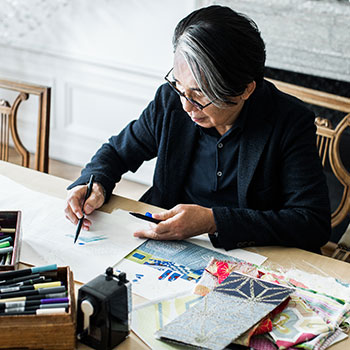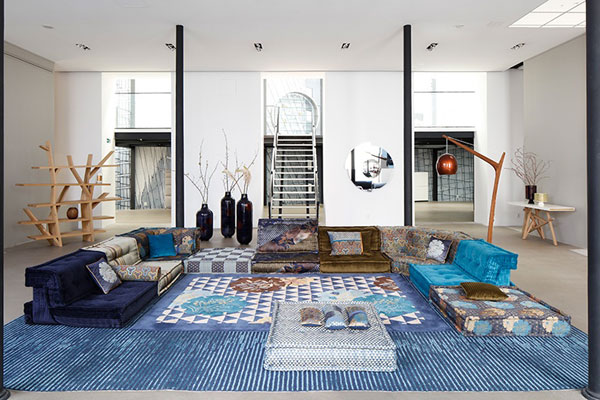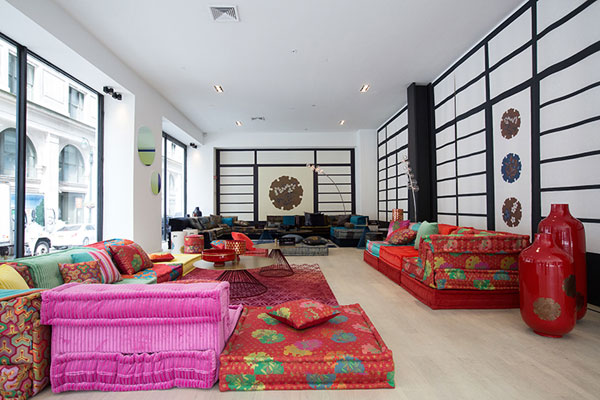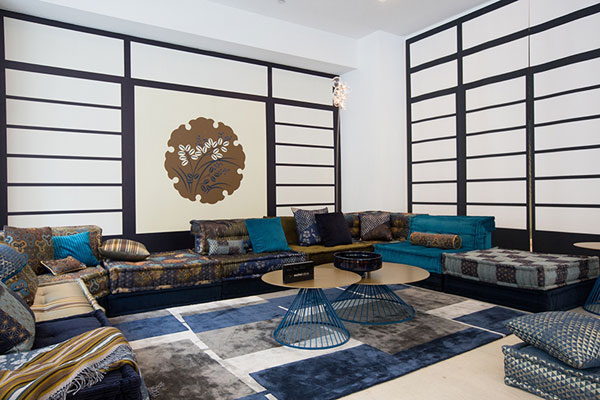Version:1.0 StartHTML:000000236 EndHTML:000001711 StartFragment:000001437 EndFragment:000001675 StartSelection:000001437 EndSelection:000001675 SourceURL:https://ez.jiagle.com/administrator/index.php?option=com_k2&view=news_list


Japanese fashion designer Kenzo Takada commanded the world’s attention in 1970 when he opened his namesake brand’s Paris boutique on Galerie Vivienne. Festooned with eclectic patterns that eschewed popular trends, Takada’s kimono-inspired garments captured the ethos of a multicultural world—and cemented his legacy in the fashion world for decades to come.
Fast forward to 2017. Takada, who stepped down from Kenzo in 1999, has kept busy by pursuing?fine arts and design. His latest endeavor may be his most impactful yet. Roche Bobois tapped Takada to redesign the brand’s iconic Mah Jong sofa, originally created?by Hans Hopfer in 1971. Using jacquard fabric from his Nogaku Collection, Takada reimagined?the piece in three colorways that symbolize morning (asa), afternoon (hiru), and evening (yoru). In addition, he designed a line of cushions, earthenware, side tables, and hand-tufted rugs. The result is a cohesive line?of furnishings that blends Takada's expertise in pattern?and texture?with Roche Bobois's distinctive?silhouettes.
We sat down with the designer, who divulged details about his upbringing in Japan, his daring journey into fashion, and his recent endeavors in the design sphere.

Inside Roche Bobois's NYC showroom, where Mah Jong sofas upholstered by Takada are on display. Image courtesy of Roche Bobois.
Interior Design: Where did you grow up and how did it influence your work?
Kenzo Takada: I grew up in Himeji, Japan, in a traditional home where my parents hosted in-house tea ceremonies. My sisters were interested in fashion and would always?bring home magazines, where I discovered the joy of color. I was around 14 years old. I then decided to study fashion and move to Paris where I have lived for over 50 years.
Before I established Kenzo in 1970, I needed to create an identity. I was working for a few companies already, but no longer wanted to follow fashion trends. I traveled back to Japan and bought some traditional textiles which I blended together in a French style that the market had not yet seen. Not only did this cause a stir in fashion at the time, but the experience helped inform much of my future work.

ID: How did the collaboration with Roche Bobois come about?
KT: We first talked about Mah Jong two years ago. I showed Roche Bobois three color ideas and they were immediately on board. The entire concept for Mah Jong is inspired by vintage kimonos and traditional patterns from Japanese Noh theater. It felt very natural. The mixing of patterns and color is very close to how I work in fashion. The most important thing is to be harmonious.
ID: Tell me about the collaborative process.
KT: Six months after we?started, I visited Roche Bobois’s factory in Italy to see the work for myself. It was overwhelming to decide which direction to take my patterns. By seeing the cutting and sewing of fabric, my ideas started to become clearer. The entire project only came together six months ago. There has been a lot of back and forth to perfect the different patterns.
After creating the sofa, we decided to branch out and design accessories—loose cushions, ceramics, rugs—that draw the collection together. The original plan was only to do one color. I presented a masculine color and a few feminine colors, but we couldn’t decide on just one, so we created all three. They were very open to using three different colors.

Mah Jong sofa upholstered with jacquard fabric from?Kenzo Takada's Nogaku Collection. Image courtesy of Roche Bobois.
ID: Your designs merge experiences in both France and Japan. How do those translate to Mah Jong?
KT: I closely follow French fashion and trends, but the only thing I know better is Japanese tradition. This is evident in Mah Jong.
ID: After you retired from Kenzo in 1999, what drove your foray into art and design?
KT: Both on the professional and personal side, I’ve always been attracted to design. Kenzo even?branched out into lines of?home products and accessories. I noticed that I’ve been purchasing more and more design objects and home goods, too.
ID: What is the most exciting intersection of design and fashion?
KT: They share the same inspiration and objective: the realized dream.
ID: What's your latest interiors pet peeve?
KT: I love harmony. Interiors should be elegant and joyful. Anything too modern risks?missing the mark. I’d like to see more of a mix of classic and contemporary in a harmonious way.

Kenzo Takada sketching in his studio. Image courtesy of Roche Bobois.
ID: Pencil, pen, or computer?
KT: Pencil. When I get inspired, I love to sketch. Working by hand brings more depth and sensation to the product you're working on.
ID: A secret source you're willing to share?
KT: Revisiting ancient Japanese materials and traditional craftsmanship.
ID: City, country, or beach?
KT: City—I'm very urban. I don't visit the countryside that uch, but I?do?try to spend holidays on the beach!










Service Hotline
Work Time:Mon-Fri 9:00-18:00
UTC+8

Sinoexpo Digital Platform
Copyright 2006-2025 Shanghai Sinoexpo Informa Markets International Exhibition Co., Ltd. All rights reserved
沪ICP备05034851号-77
 沪公网安备 31010402000543号
沪公网安备 31010402000543号